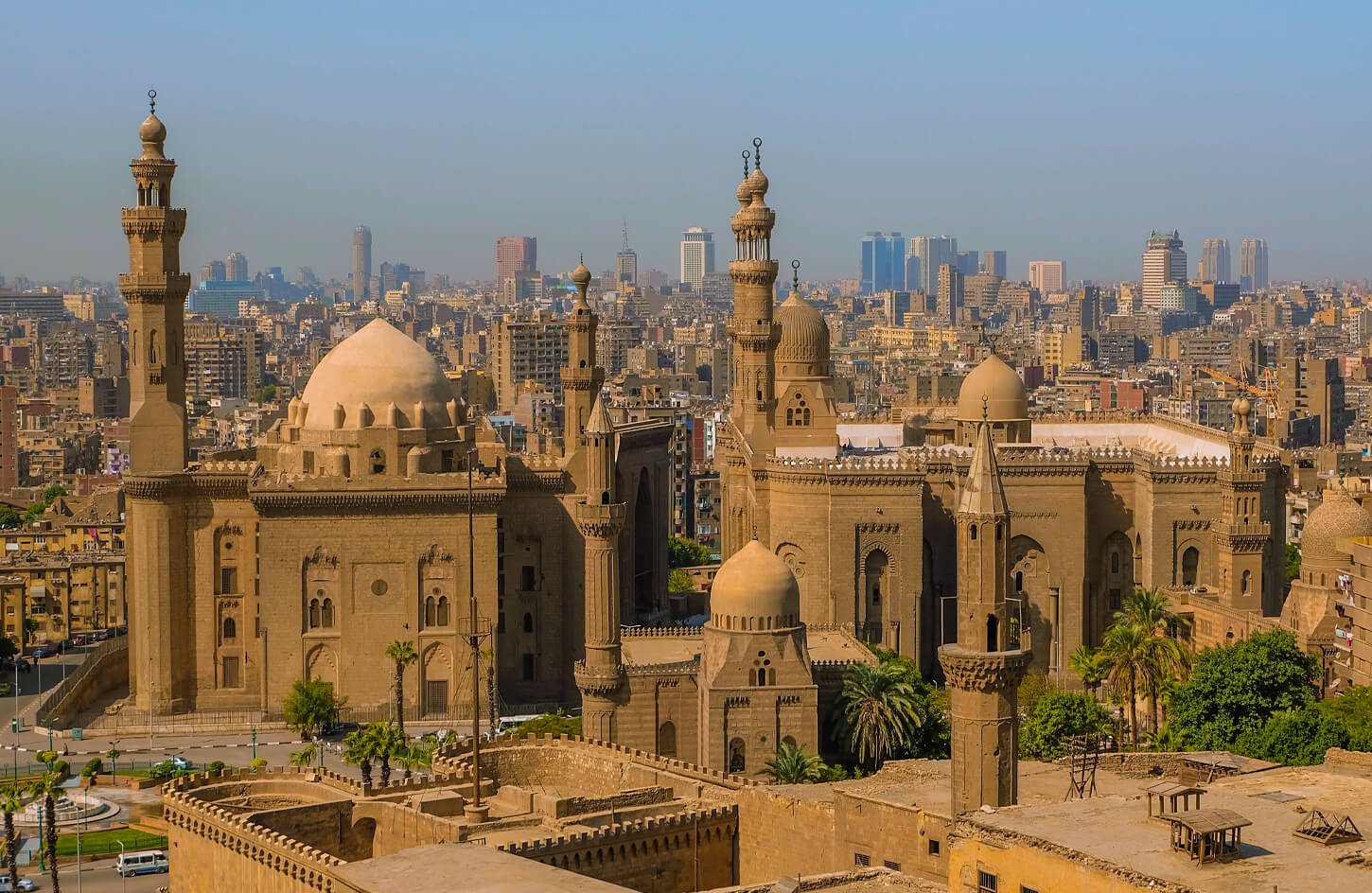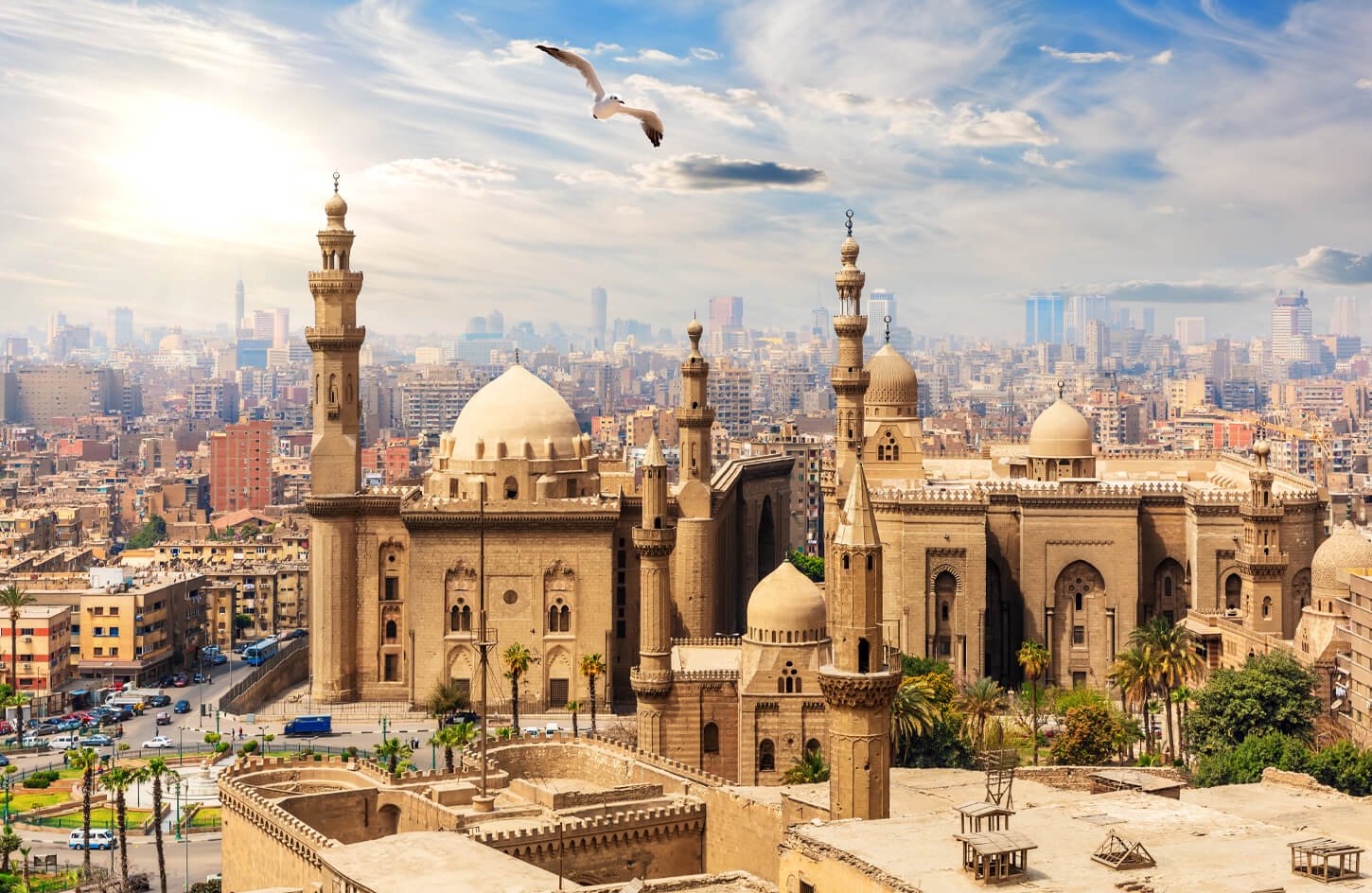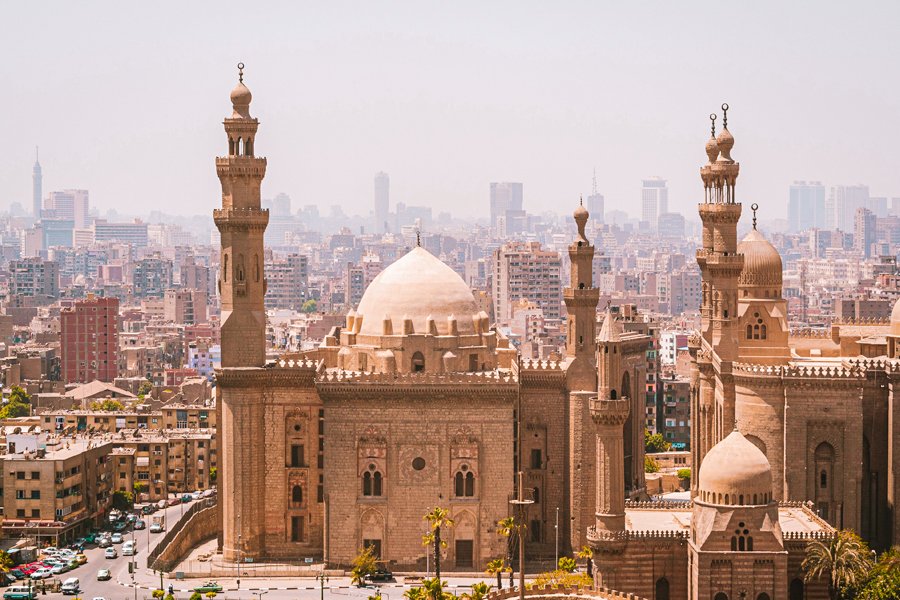The Sultan Hassan Mosque is a significant historical and architectural marvel renowned for its remarkable design and intricate craftsmanship. This mosque is important in Islamic and architectural spheres, situated in Cairo, Egypt. To truly appreciate the significance of this mosque, it is essential to delve into its brief history and understand its role in Islamic architecture.
The Sultan Hassan Mosque has a rich history dates back to the 14th century. It was constructed during the reign of Sultan Hassan bin Al-Nasir Muhammad, who ruled Egypt from 1356 to 1361. Sultan Hassan was a powerful and ambitious leader, and he envisioned a grand mosque that would not only serve as a place of worship but also stand as a symbol of his authority and magnificence.
The mosque’s construction commenced in 1356 under the guidance of esteemed architects and skilled craftsmen. It took several years to complete the project, and the mosque was finally inaugurated in 1363. The Sultan Hassan Mosque was built on the site of the ancient Fatimid Palace, which added to its historical significance.
The mosque’s architecture is a testament to the grandeur and elegance of the Mamluk era. It embodies the unique characteristics of Islamic architecture, combining elements from various architectural styles prevalent during that period. The mosque showcases exquisite craftsmanship, intricate geometric patterns, and intricate calligraphy, prominent Islamic art and design features.
Architecture and Design of Sultan Hassan Mosque
The Sultan Hassan Mosque boasts a magnificent architectural design that mesmerizes visitors with its intricate details and awe-inspiring grandeur. The mosque’s exterior and interior showcase the splendor of Islamic architecture, incorporating elements characteristic of the era in which it was built.
1. Exterior Design
The exterior of the Sultan Hassan Mosque is imposing and majestic. The mosque features towering minarets that reach toward the sky, serving as prominent markers of its presence. With their graceful tapering form, these minarets are adorned with ornate geometric patterns and Arabic calligraphy. They serve as architectural elements and act as beacons for the faithful, announcing the call to prayer.
The façade of the mosque is characterized by intricately carved stone walls and decorative elements. Delicate geometric patterns, interlacing arches, and arabesque motifs adorn the exterior, creating a mesmerizing visual display. These ornamental details are meticulously crafted and reflect the mastery of the craftsmen who brought the mosque to life.
2. Interior Design
As one enters the Sultan Hassan Mosque, they are greeted by a vast, awe-inspiring interior space. The prayer hall, known as the hypostyle hall, is an architectural marvel. It features a forest of massive columns that support the intricately decorated ceiling. The columns are arranged symmetrically, creating a sense of harmony and balance.
The mosque’s interior walls are adorned with decorative elements, including intricate tile work, carved stone panels, and beautiful calligraphy. Arabic inscriptions from the Quran and other Islamic texts can be found throughout the interior, serving as a reminder of the spiritual significance of the space.
The mihrab, a niche in the wall that indicates the direction of Mecca, is an essential feature of the mosque’s interior. The mihrab is exquisitely decorated with intricate geometric patterns and calligraphy, serving as a focal point for worshippers during prayer.

3. Features of Islamic Architecture
The Sultan Hassan Mosque incorporates several features that are characteristic of Islamic architecture. These features include:
- Geometric Patterns: Islamic architecture is renowned for its extensive use of geometric patterns. The mosque showcases intricate geometric designs on its exterior and interior, often featuring motifs such as stars, interlocking shapes, and tessellations. These patterns serve an aesthetic purpose and convey a deeper symbolism and harmony.
- Calligraphy: Arabic calligraphy holds great significance in Islamic art and architecture. The Sultan Hassan Mosque incorporates beautiful calligraphy throughout its design, with verses from the Quran and religious texts adorning the walls. The calligraphy adds a spiritual dimension to the space and showcases the reverence for the written word.
- Arches and Vaults: The mosque features numerous arches and vaults, common elements in Islamic architecture. These architectural elements provide structural support while also creating visually striking spaces. The arches and vaults in the Sultan Hassan Mosque are intricately designed and add to the overall beauty and grandeur of the interior.
- Courtyard: Islamic architecture often includes a central courtyard, which serves as a gathering space and provides natural light and ventilation. The Sultan Hassan Mosque incorporates a spacious courtyard surrounded by arcades and adorned with decorative elements. The courtyard offers a tranquil environment for reflection and communal activities.
The Historical Significance
The Sultan Hassan Mosque played a pivotal role in Islamic history. It was constructed during the Mamluk period in the 14th century under the rule of Sultan Hassan. The mosque served as a center for religious and educational activities, attracting scholars and students from far and wide.
Several significant events unfolded within the mosque’s walls. It witnessed religious ceremonies, including Friday prayers and religious festivals, which brought the community together. It also hosted lectures and scholarly debates, fostering intellectual exchange and learning.
The Religious Significance of the Mosque of Sultan Hassan
The Sultan Hassan Mosque holds great religious significance within the Islamic faith, serving as a sacred space for worship and spiritual reflection. It has played a vital role in the religious lives of Muslims, offering a place for various religious rituals and practices.
1. Place of Worship
The mosque serves as a central place of worship for Muslims in the local community and beyond. It provides a sanctuary for daily prayers, Friday congregational prayers (Jumu’ah), and special prayers during Islamic festivals. The grand prayer hall within the mosque accommodates many worshippers, allowing them to unite in unity and devotion.
2. Friday Sermons (Khutbah)
A significant religious ritual occurs every Friday in the Sultan Hassan Mosque—the Friday Sermon (Khutbah). An imam, or religious leader, delivers a sermon addressing the congregation, providing guidance, and imparting religious teachings. The sermon serves as a source of spiritual nourishment and community bonding, reinforcing the principles and values of Islam.
3. Eid Prayers
The mosque holds special religious significance during Islamic festivals, especially Eid al-Fitr and Eid al-Adha. On these occasions, worshippers gather at the Sultan Hassan Mosque to perform the Eid prayers, which mark the culmination of Ramadan and the commemoration of Prophet Abraham’s willingness to sacrifice his son. The mosque becomes a vibrant hub of celebration and community, fostering a sense of joy and togetherness among Muslims.
4. Spiritual Reflection and Duaa (Supplication)
The Sultan Hassan Mosque provides a serene and peaceful environment for spiritual reflection and personal connection with Allah. Worshippers visit the mosque to seek solace, offer individual prayers, and engage in supplication (duaa). The mosque’s tranquil courtyards and serene ambiance facilitate a spiritual atmosphere, allowing individuals to find solace and peace amidst their daily lives.
5. Islamic Education
The mosque has historically been a center for Islamic education and the dissemination of religious knowledge. It has hosted Quranic recitation classes, religious lectures, and discussions led by esteemed scholars and teachers. The mosque’s role in education reinforces its religious significance, as it helps cultivate a knowledgeable and spiritually aware community.
6. Community Engagement and Social Services
The Sultan Hassan Mosque is also crucial in community engagement and social services. It serves as a gathering place for various social and charitable activities, such as distributing food to the needy, organizing community events, and supporting those in need. These initiatives reflect the mosque’s commitment to the principles of compassion, generosity, and community solidarity taught in Islam.

Cultural Significance
The Sultan Hassan Mosque has deeply influenced Egyptian culture. Its architectural splendor and historical significance have made it an iconic symbol of Cairo. The mosque’s magnificence has inspired artists, poets, and writers to celebrate its beauty and contribute to its cultural legacy.
Furthermore, the mosque’s architectural style has influenced other Islamic structures within Egypt and beyond. Its design principles and decorative elements have inspired subsequent architectural endeavors, leaving a lasting impact on Islamic architectural traditions.
Planning to Visit the Mosque of Sultan Hassan?
Visiting the Sultan Hassan Mosque offers a unique opportunity to explore Egypt’s rich culture to witness the fusion of artistic brilliance and spiritual devotion. Exploring its architectural splendor, immersing oneself in its serene atmosphere, and delving into its historical significance provide a profound understanding of the mosque’s importance. Here is some essential information to enhance your experience:
- Location: The Sultan Hassan Mosque is in the historic area of Cairo, Egypt. It is situated near the Citadel of Salah al-Din and is easily accessible by public transportation or taxi.
- Dress Code: It is essential to dress modestly and respectfully as a place of worship. Both men and women should ensure their shoulders, chest, and knees are covered. Women may consider bringing a scarf to cover their hair.
- Opening Hours: The mosque is generally open to visitors during daylight hours. It is recommended to check the specific visiting hours beforehand, as they may vary depending on religious activities or restoration work.
- Guided Tours: Consider joining a guided tour to understand better the mosque’s history, architecture, and cultural significance. Professional guides can provide valuable insights and answer any questions you may have.
- Check out our Egypt Vacation Packages and Enjoy your visit to the Sultan Hassan Mosque on a guided tour and embrace the beauty of this remarkable cultural treasure!
What to Expect When Visiting the Mosque?
- Architecture and Design: Prepare to be mesmerized by the mosque’s impressive architecture and intricate design details. From the towering minarets to the grand prayer hall adorned with calligraphy and geometric patterns, every corner of the mosque showcases the brilliance of Islamic architecture.
- Spiritual Atmosphere: The mosque offers a serene and tranquil ambiance, creating a peaceful atmosphere for prayer and reflection. Visitors must maintain a quiet and respectful demeanor inside the mosque.
- Photography: Photography is usually permitted in designated areas of the mosque. However, it is crucial to be mindful of other worshippers and to respect any signage or guidelines regarding photography restrictions.
Best Time to Visit the Mosque of Sultan Hassan?
- Weekdays: If possible, plan your visit on weekdays rather than weekends, as the mosque tends to be less crowded during weekdays. This allows for a more peaceful and immersive experience.
- Morning Visits: Consider visiting the mosque in the morning when it first opens. This allows you to avoid peak visiting hours and enjoy a quieter atmosphere.
- Seasonal Considerations: Remember that Cairo can experience high temperatures, particularly during summer. It is advisable to visit during the cooler parts of the day or opt for a visit during the milder seasons for a more comfortable experience.
Remember to check local regulations, visiting hours, and any updates before your visit, as circumstances may vary. Respecting the mosque’s cultural and religious significance will ensure a memorable and meaningful experience for you and other visitors.
The Sultan Hassan Mosque is an extraordinary testament to the rich heritage of Islamic architecture and culture. Its historical, religious, and cultural significance makes it an architectural masterpiece that continues to captivate visitors and scholars alike. It is a remarkable testament to its builders’ ingenuity and artistic genius. As visitors and admirers continue to explore its grandeur, the Sultan Hassan Mosque will forever hold a special place in the annals of Islamic architecture and culture.
Read More of Cairo Attractions:


0 Comment